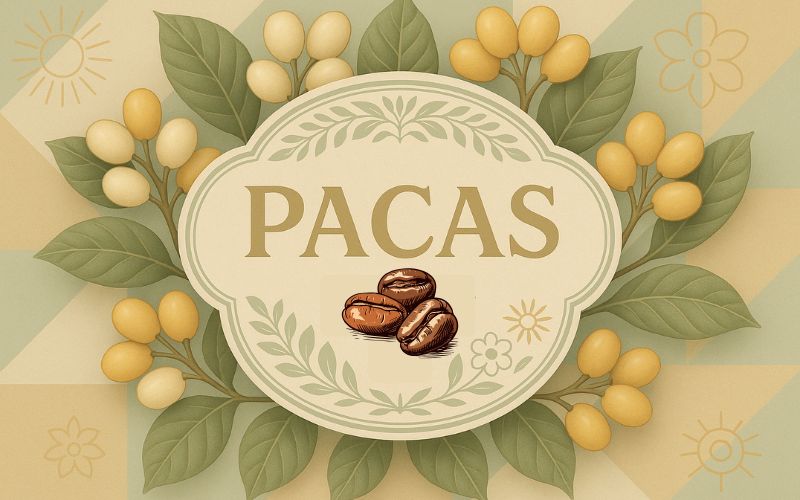
Pacas: El Salvador's Gift to Coffee
Discover Pacas, the natural dwarf mutation of Bourbon discovered and cultivated by the famous Pacas family in El Salvador. Learn how its compact size and good cup quality have made it a cornerstone of Central American coffee, and how it became a parent to the celebrated Pacamara variety.
Pacas: A Family's Fortunate Discovery
The story of the Pacas coffee variety is a story of a family's keen observation and their lasting contribution to the coffee world. Like Caturra, Pacas is a natural dwarf mutation of the Bourbon variety, meaning it is small and compact, allowing for dense planting and high yields.
Discovered in El Salvador in the middle of the 20th century, the Pacas variety has become a cornerstone of the coffee industry in that country and beyond. It is known for its resilience and its ability to produce a high-quality cup with a balanced and pleasing flavor profile.
Perhaps most famously, the Pacas variety is one of the parents of the spectacular Pacamara hybrid, a true giant in the specialty coffee world.
The Pacas Family Legacy
The variety was discovered in 1949 by the Pacas family on their farm, Finca San Rafael, on the slopes of the Santa Ana volcano in El Salvador. Don Francisco Pacas and his sons were inspecting their fields of Bourbon coffee trees when they noticed one that was markedly different.
This tree was much smaller, more compact, and had a very dense foliage, yet it was loaded with coffee cherries. Recognizing that this could be a significant discovery, they began to cultivate the seeds from this single tree separately.
The variety proved to be stable, retaining its dwarf characteristics through generations. The family named it "Pacas" in their honor. In 1960, the Salvadoran Coffee Research Institute (ISIC) began a program of selection to further improve the variety, and it was soon distributed to farmers throughout the country.
A Balanced and Approachable Cup
The flavor profile of Pacas is very similar to its parent, Bourbon, but it often has a softer acidity and a creamier body, making it a very balanced and approachable coffee.
- Acidity: The acidity is typically medium in intensity, with a gentle sweetness. It often has a pleasant citrus or floral character.
- Body: Pacas is known for its medium to full body, which is often described as smooth and creamy.
- Aroma: The aromatics are sweet and can be quite complex, with notes of spice, chocolate, and flowers.
- Flavor: Look for a good balance of flavors. Common notes include milk chocolate, nuts, and a gentle, sweet citrus fruitiness.
A well-grown Pacas offers a wonderfully satisfying and well-rounded cup that is less sharp than a Caturra and has a bit more body and sweetness.
Agricultural Advantages
The Pacas variety shares many of the same agricultural advantages as Caturra, which made it very popular with farmers.
- Compact Size: Its dwarfism allows for high-density planting, increasing the overall productivity of a farm.
- Good Yields: It is a productive variety, especially when managed with good fertilization.
- Wind Resistance: Its compact and sturdy structure makes it more resistant to wind damage than the taller, more lanky Typica and Bourbon varieties.
- Drought Tolerance: It is also known to have good tolerance to dry conditions.
Like its parent, Bourbon, Pacas is unfortunately susceptible to coffee leaf rust and other diseases, which remains a significant challenge for the farmers who grow it.
Key Growing Regions
Pacas is most closely associated with its home country of El Salvador, but it is grown elsewhere in Central America as well.
- El Salvador: This is the heartland of the Pacas variety. It is widely grown throughout the country and is a key component of many of the nation's best coffees.
- Honduras: Pacas is also a common variety in Honduras, where it contributes to the country's diverse range of coffee profiles.
Brewing for Balance and Body
To highlight the creamy body and balanced flavors of Pacas, brewing methods that favor a fuller extraction are a good choice.
- Recommended Methods: A French Press can produce a rich and full-bodied cup that showcases the coffee's chocolatey notes. For a cleaner but still full-flavored brew, a flat-bottom pour-over brewer like the Kalita Wave is an excellent option.
- Ratio and Grind: Don't be afraid to use a slightly tighter coffee-to-water ratio (like 1:15) to enhance the sweetness and body. A medium grind is a good starting point for most brewing methods.
The Famous Parent of Pacamara
The most famous role of the Pacas variety is as a parent to the celebrated Pacamara hybrid. In 1958, researchers at ISIC in El Salvador decided to cross the small-statured Pacas with the giant-beaned Maragogipe.
The goal was to create a new variety that had the large bean size of Maragogipe but the compact, productive growth habit of Pacas. The result was Pacamara, a variety that has become one of the most sought-after and exotic coffees in the specialty world.
Conclusion: A Salvadoran Treasure
The Pacas variety is a perfect example of how the keen eye of a single family can have a lasting impact on an entire industry. It is a Salvadoran treasure that has become a vital part of the coffee landscape in Central America.
While it may sometimes be overshadowed by its famous offspring, Pacamara, the Pacas variety stands on its own as a coffee that offers a wonderfully balanced, sweet, and satisfying cup. It is a testament to the ongoing story of discovery and innovation that makes the world of coffee so fascinating.


